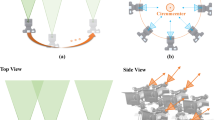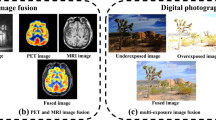Abstract
2D to 3D conversion is an important task for 3DTV broadcasting services due to the lack of stereoscopic 3D contents. In this paper, we propose 2D to 3D conversion with motion-type adaptive depth estimation. Because the most important depth cue is motion parallax in our method, we first perform motion estimation between sequential video frames. Then, we adopt a motion-type adaptive approach to depth map estimation because videos have different depth structures according to the type of motion. To be specific, depth from motion is exploited to estimate depth maps in the case of global motion while the depth maps are generated based on the depth from template with the local motion-guided refinement in the case of local motion. Finally, we employ depth image-based rendering (DIBR) to generate stereoscopic virtual views from the depth maps. Experimental results demonstrate that the proposed 2D to 3D conversion is very effective in generating accurate depth maps and providing realistic 3D effects.















Similar content being viewed by others
References
Tam, W.J., Zhang, L.: “3D-TV content generation: 2d-to-3d conversion”. In: Proceedings of IEEE International Conference on Multimedia and Expo (ICME), pp. 1869–1872 (2006)
Wiegand, T., Sullivan, G.J., Bjontegaard, G., Luthra, A.: Overview of the H. 264/AVC video coding standard. IEEE Trans. Circuits Syst. Video Technol. 13(7), 560–576 (2003)
Varodayan, D., Chen, D., Flierl, M., Girod, B.: “Wyner–Ziv coding of video with unsupervised motion vector learning,” Signal Processing: Image Communication, pp. 369–378 (2008)
Chen, D., Tsai, S., Chandrasekhar, V., Takacs, G., Vedantham, R., Grzeszczuk, R., Girod, B.: Residual enhanced visual vector as a compact signature for mobile visual search. Sig. Process. 93(8), 2316–2327 (2013)
Wang, H., Schuster, G.M., Katsaggelos, A.K.: Rate-distortion optimal bit allocation for object-based video coding. IEEE Trans. Circuits Syst. Video Technol. 15(9), 1113–1123 (2005)
Zhu, L., Fan, Z., Aggelos, K.K.: “Joint video summarization and transmission adaptation for energy-efficient wireless video streaming,” EURASIP J Adv Signal Process, vol. 2008, Article ID 657032 (2008)
Smolic, A., Kauff, P., Knorr, S., Hornung, A., Kunter, M., Muller, M., Lang, M.: Three-dimensional video postproduction and processing. Proc. IEEE 99(4), 607–625 (2011)
Pitas, I., Nikolaidis, N.:“Anthropocentric video analysis for film and games postproduction”. In: Proceedings of the 11th International Conference on Computer Systems and Technologies and Workshop for PhD Students in Computing on International Conference on Computer Systems and Technologies pp. 11–18 (2010)
Daribo, I., Saito, H.: A novel inpainting-based layered depth video for 3DTV. IEEE Trans. Broadcast. 57(2), 533–541 (2011)
Holte, M.B., Moeslund, T.B., Nikolaidis, N., Pitas, I.: “3D human action recognition for multi-view camera systems”. In: Proceedings of International Conference on 3D Imaging, Modeling, Processing, Visualization and Transmission (3DIMPVT), pp. 342–349 (2011)
Liao, M., Gao, J., Yang, R., Gong, M.: Video stereolization: combining motion analysis with user interaction. IEEE Trans. Visual Comput. Graphics 18(7), 1079–1088 (2012)
Yang, N.E., Lee, J.W., Park, R-H.: “Depth map generation from a single image using local depth hypothesis”. In: Proceedings of IEEE International Consumer Electronics (ICCE), pp. 311–312 (2012)
Zhang, L., Vazquez, C., Knorr, S.: 3D-TV content creation: automatic 2D-to-3D video conversion. IEEE Trans. Broadcast. 99, 1–12 (2011)
Kim, D., Min, D., Sohn, K.: A stereoscopic video generation method using stereoscopic display characterization and motion analysis. IEEE Trans. Broadcast. 54, 188–197 (2008)
Pourazad, M.T., Nasiopoulos, P., Ward, R.K.: An H. 264-based scheme for 2D to 3D video conversion. IEEE Trans. Consum. Electron. 55, 742–748 (2008)
Lai, Y.K., Lai, Y.F., Chen, Y.C.: “An effective hybrid depth-perception algorithm for 2D-to-3D conversion in 3D display systems”. In: Proceedings IEEE ICCE, pp. 612–613 (2012)
Yu, F., Liu, J., Ren, Y., Sun, J., Gao, Y., Liu, W.: “Depth generation method for 2D to 3D conversion”. In: Proceedings 3DTV-Con (2011)
Jung, Y.J., Baik, A., Kim, J., Park, D.: “A novel 2D-to-3D conversion technique based on relative height depth cue”. In: Proceedings SPIE Electronics Imaging, Stereoscopic Displays and Applications (2009)
Cheng, C.C., Li, C.T., Chen, L.-G.: A novel 2d-to-3d conversion system using edge information. IEEE Trans. Consum. Electron. 56(3), 1739–1745 (2010)
Zhang, Z., Wang, Y., Jiang, T., Gao, W.: “Visual pertinent 2D-to-3D video conversion by multi-cue fusion”. In: Proceedings of IEEE International Conference on Image Processing (ICIP), pp. 909–912 (2011)
Kraemer, P., Benois-Pineau, J.: “Camera motion detection in the rough indexing paradigm”. In: TREC Video Retrieval Evaluation Online Proceedings, TRECVID05 (2005)
Tao, M.W., Bai, J., Kohli, P., Paris, S.: SimpleFlow: a non-iterative, sublinear optical flow algorithm. Comput Graphics Forum 31(2), 345–353 (2012)
Liu, C., Christopher, L.: “Depth map estimation from motion for 2D to 3D conversion”. In: Proceedings of IEEE International Conference on Electro/Information Technology (EIT), pp. 1–4 (2012)
Han, K., Hong, K.: “Geometric and texture cue based depth-map estimation for 2D to 3D image conversion”. In: Proceedings of IEEE International Conference on Consumer Electronics (ICCE), (2011)
Duda, R.O., Hart, P.E.: “Use of the hough transformation to detect lines and curves in pictures”, In: AI Center, SRI International (1971)
Zhang, X., Yang, Y.: “Minimum spanning tree and color image segmentation”. In: Proceedings of IEEE International Conference on Networking, Sensing and Control, pp. 900–904 (2008)
Tomasi, C., Manduchi, R.: “Bilateral filtering for gray and color images”. In: Proceedings of International Conference on Computer Vision (ICCV) (1998)
Petschnigg, G., Szeliski, R., Agrawala, M., Cohen, M., Hoppe, H., Toyama, K.: “Digital photography with flash and no-flash image pairs”. In: Proceedings of ACM SIGGRAPH, pp. 664–672 (2004)
Fehn, C.: “A 3D-TV approach using depth-image-based rendering (DIBR)”. In: Proceedings Of Visualization, Imaging, and Image Processing, pp. 482–487 (2003)
Fehn, C.: “Depth-image-based rendering (DIBR), compression and transmission for a new approach on 3D-TV”. In: Proceedings SPIE 5291, Stereoscopic Displays and Virtual Reality Systems XI (2004)
Wang, Z., Bovik, A.C., Sheikh, H.R., Simoncelli, E.P.: Image quality assessment: from error visibility to structural similarity. IEEE Trans. Image Process. 13(4), 600–612 (2004)
Wang, Z., Bovik, A.C.: A universal image quality index. IEEE Signal Process. Lett. 9(3), 81–84 (2001)
Sheikh, H.R., Bovik, A.C.: Image information and visual quality. IEEE Trans. Image Process. 15(2), 430–444 (2006)
Moorthy, A.K., Bovik, A.C.: A two-step framework for constructing blind image quality indices. IEEE Signal Process. Lett. 17(5), 513–516 (2010)
Acknowledgments
The authors would like to thank the anonymous reviewers for their valuable comments that have led to improvements in the quality and presentation of the paper. This work was supported by the National Natural Science Foundation of China (No. 61271298) and the International S&T Cooperation Program of China (No. 2014DFG12780).
Author information
Authors and Affiliations
Corresponding author
Additional information
Communicated by P. Pala.
Rights and permissions
About this article
Cite this article
Jung, C., Wang, L., Zhu, X. et al. 2D to 3D conversion with motion-type adaptive depth estimation. Multimedia Systems 21, 451–464 (2015). https://doi.org/10.1007/s00530-014-0375-z
Received:
Accepted:
Published:
Issue Date:
DOI: https://doi.org/10.1007/s00530-014-0375-z




